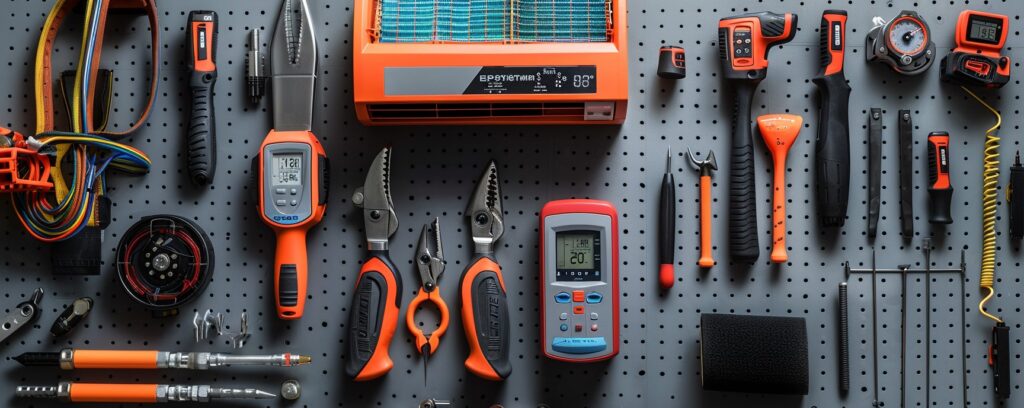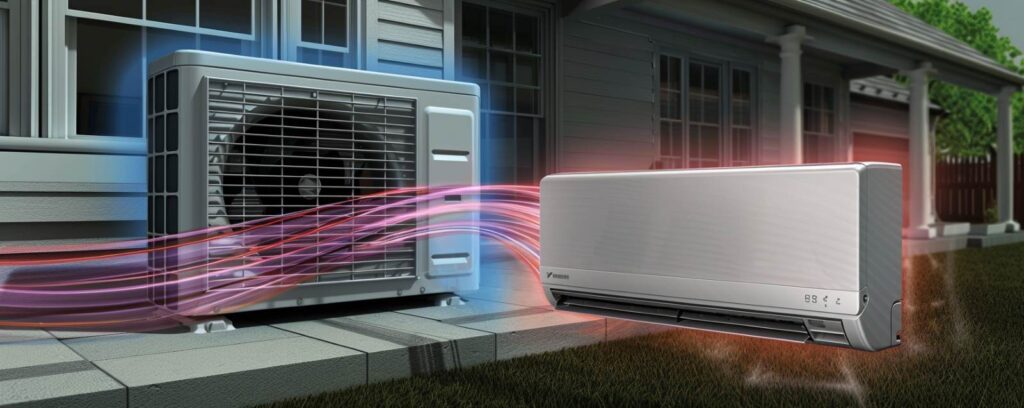The role of HVAC technicians is critical in ensuring comfortable and safe living environments. These professionals are responsible for installing, maintaining, and repairing heating, ventilation, and air conditioning systems. With the ever-evolving nature of HVAC technology, there is a growing demand for skilled technicians who can keep up with the latest advancements. HVAC technicians not only help in maintaining indoor air quality but also contribute to energy efficiency and sustainability. For those considering a career in this field, understanding the essential tools used by HVAC technicians is a crucial step.
The Importance of Tools in the HVAC Trade
In the HVAC industry, having the right tools is paramount for efficiency and accuracy. As HVAC technology continuously evolves, the tools and skills required for servicing equipment also change. Technicians must stay updated with new tools and techniques to handle modern HVAC systems effectively. This HVAC tools list provides an overview of the essential tools every technician needs. Whether you’re an aspiring HVAC technician or a seasoned professional looking to update your toolkit, understanding these tools is key to success in the trade.
General-Use Tools
Allen Wrenches/Hex Keys
Allen wrenches, also known as hex keys, are indispensable for assembling and disassembling equipment that uses hexagonal socket screws. These tools come in various sizes and are crucial for tasks that require precision and torque. A set of high-quality Allen wrenches ensures you can handle a wide range of fasteners securely and effectively.
Cordless Drills/Impact Drivers
Drills are essential for creating holes and driving screws into various materials. A cordless drill is particularly useful for HVAC technicians as it provides mobility and ease of use in different work environments. Cordless impact drivers are powerful tools designed for driving screws and bolts quickly and efficiently. They provide high torque and speed, making them ideal for heavy-duty tasks. Investing in a reliable drill with multiple speed settings and a range of drill bits can enhance your capability to handle various installation and repair tasks.
Flashlights/Headlamps
Flashlights and headlamps are essential for providing illumination in dark or poorly lit areas. These tools allow HVAC technicians to work safely and accurately in crawl spaces, attics, and other dim environments. A reliable flashlight or headlamp ensures you can see clearly, reducing the risk of errors and accidents during inspections and repairs.
Hammers
Hammers, including claw hammers and mallets, are used for driving nails, removing components, and adjusting parts. They are essential for making quick adjustments and repairs. Ensuring you have a variety of hammers can help you handle different tasks effectively.
Levels
Levels, such as spirit levels and laser levels, ensure that installations are perfectly horizontal or vertical. Accurate leveling is crucial for the proper functioning of HVAC systems. Investing in a high-quality level can help you achieve precision in your installations and repairs.
Multimeters
Multimeters are vital for diagnosing electrical issues within HVAC systems. They measure voltage, current, and resistance, allowing technicians to troubleshoot and repair electrical components safely. A reliable multimeter can help you quickly identify and address electrical problems, ensuring the proper functioning of HVAC systems.
Pliers
Pliers, including needle-nose and channel-lock pliers, are versatile tools used for gripping, bending, and cutting wires and other materials. They are essential for making adjustments and repairs in tight spaces. High-quality pliers can improve your ability to manipulate small components and ensure secure connections.
Screwdrivers
Screwdrivers are a staple in any technician’s toolkit. They are used for assembling and disassembling components in HVAC systems. Various types of screwdrivers, such as flathead and Phillips, are necessary to handle different types of screws found in HVAC equipment. Ensuring you have a high-quality set of screwdrivers can make your work more efficient and reduce the risk of damaging components.
Tape Measures
Accurate measurements are crucial in the HVAC trade. Tape measures are used for sizing ducts, determining the placement of units, and ensuring components fit correctly. A durable tape measure with clear markings can help ensure precision in your work, ultimately leading to more efficient and effective installations.
Utility Knives
Utility knives are used for cutting insulation, duct tape, and other materials. A sharp utility knife is essential for making clean and precise cuts. Keeping your utility knife in good condition can help you work more efficiently and safely.
Wire Strippers
Wire strippers are used for removing insulation from electrical wires. They are crucial for preparing wires for connections and ensuring secure electrical contacts. A reliable pair of wire strippers can help you perform electrical work more efficiently and safely.
Wrenches
Wrenches, such as adjustable wrenches and pipe wrenches, are used for tightening and loosening nuts, bolts, and pipes. These tools are crucial for assembling and disassembling HVAC components securely. A good set of wrenches can help you perform tasks more efficiently and reduce the risk of damaging fittings.
HVAC-Specific Tools
Duct Gauges
Duct gauges are used to measure air velocity and static pressure in ductwork. These measurements are crucial for assessing the performance of HVAC systems and ensuring they operate efficiently. By using duct gauges, technicians can diagnose issues, balance airflows, and make necessary adjustments to improve system functionality.
Fin Combs
Fin combs are tools designed to straighten and clean the fins on condenser and evaporator coils. Over time, fins can become bent or clogged with debris, reducing the efficiency of the HVAC system. Using a fin comb restores the fins to their optimal condition, improving heat exchange and ensuring the system runs smoothly.
Flaring Tools
Flaring tools are used to create flares at the ends of refrigerant lines, ensuring secure connections. Properly flared connections are essential to prevent leaks and maintain system integrity. Investing in a reliable flaring tool can help technicians achieve consistent, high-quality flares.
HVAC Software Tools
HVAC software tools assist technicians in system diagnostics, maintenance scheduling, and reporting. These tools can analyze system performance, predict maintenance needs, and generate detailed reports, enhancing the technician’s ability to provide top-notch service. Utilizing advanced HVAC software can streamline operations and improve accuracy.
Leak Detectors
Leak detectors are used to identify refrigerant leaks within an HVAC system. Early detection of leaks is crucial for maintaining system efficiency and preventing environmental harm. Modern electronic leak detectors are highly sensitive and can quickly pinpoint the source of leaks, allowing for prompt repairs.
Manifold Gauges
Manifold gauges are essential tools for diagnosing and repairing HVAC systems. They measure the pressure of refrigerants within the system, helping technicians identify leaks, blockages, and other issues. A high-quality set of manifold gauges allows for accurate readings and effective troubleshooting.
Nitrogen Regulator and Hose
A nitrogen regulator and hose are used for pressure testing and purging air conditioning and refrigeration systems. These tools help identify leaks and ensure that the system is free of contaminants. Proper use of a nitrogen regulator and hose enhances the reliability and efficiency of HVAC systems, preventing potential failures and ensuring optimal performance.
Pipe Benders
Pipe benders are specialized tools used to bend pipes without kinking or damaging them. This is essential for proper installation and maintenance of HVAC systems. Using a pipe bender ensures that your piping fits correctly and maintains its integrity, which is critical for system performance and longevity.
Psychrometers
Psychrometers measure humidity levels and temperature, providing data on the air’s moisture content. This information is vital for diagnosing issues related to indoor air quality and system performance. Accurate humidity measurements help in determining the right settings for dehumidifiers and other HVAC components.
Refrigerant Recovery Machines
Refrigerant recovery machines are used to safely remove refrigerant from HVAC systems. This is a critical step in maintaining environmental safety and compliance with regulations. These machines ensure that refrigerants are recovered efficiently and can be reused or disposed of properly.
Refrigerant Scales
Refrigerant scales are crucial for accurately measuring the amount of refrigerant being added to or removed from an HVAC system. Proper refrigerant levels are essential for the system’s efficiency and performance. A good refrigerant scale ensures precise measurements, helping technicians avoid undercharging or overcharging the system, which can lead to inefficiencies or damage.
Thermometers
Thermometers are used to measure temperature differences in various parts of an HVAC system. Technicians rely on thermometers to ensure that the system is heating or cooling as expected. Different types of thermometers, including digital and infrared, provide quick and accurate readings, allowing for efficient diagnostics and adjustments.
Tubing Cutters
Tubing cutters are used to cut pipes and tubing cleanly and accurately. This tool is essential for preparing refrigerant lines and other HVAC components for assembly. A good tubing cutter ensures smooth, burr-free cuts, which are crucial for proper fitting and sealing.
Vacuum Pumps
Vacuum pumps are used to evacuate air and moisture from HVAC systems before charging them with refrigerant. Removing these contaminants is vital for the system’s efficiency and longevity. A high-performance vacuum pump ensures a thorough evacuation, preparing the system for optimal operation.
Frequently Asked Questions
What is the initial investment for HVAC tools?
The initial investment for HVAC tools can vary depending on the quality and range of tools purchased. On average, new HVAC technicians can expect to spend between $500 to $1,500 on essential tools. This investment includes general-use tools like screwdrivers, drills, and tape measures, as well as HVAC-specific tools such as manifold gauges and refrigerant scales. While this may seem like a significant upfront cost, investing in high-quality tools can enhance efficiency and durability, ultimately saving money in the long run.
Do HVAC companies supply new technicians with tools?
Many HVAC companies provide new technicians with a basic set of tools, especially those that are company-specific or particularly expensive. However, it is common for technicians to gradually build their own toolkits as they gain experience and identify personal preferences. Companies may offer tool allowances or reimbursements to help technicians acquire the necessary tools over time. It’s important for aspiring HVAC technicians to inquire about tool policies during the hiring process.
How do aspiring technicians learn to use HVAC tools?
Aspiring HVAC technicians typically learn to use tools through a combination of formal education and hands-on experience. HVAC training programs, which can be found at technical schools and community colleges, provide foundational knowledge and practical training on tool usage. Additionally, apprenticeships and on-the-job training offer real-world experience under the guidance of experienced professionals. Continuous learning and practice are essential, as new tools and technologies are regularly introduced in the HVAC industry.
Final Thoughts on HVAC Tools
Having a comprehensive HVAC tools list is essential for anyone pursuing a career as an HVAC technician. The right tools not only enhance efficiency and accuracy but also ensure safety and reliability in every task performed. From general-use tools like screwdrivers and drills to HVAC-specific tools such as manifold gauges and refrigerant recovery machines, each tool plays a critical role in the day-to-day operations of an HVAC technician.
Investing in high-quality tools is a wise decision for long-term success in the HVAC industry. Quality tools are more durable, provide more precise results, and can withstand the rigors of daily use. Additionally, staying updated with the latest tools and technologies is crucial as the HVAC industry continues to evolve. This ongoing learning and adaptation help technicians remain competitive and effective in their roles.
For aspiring HVAC technicians, building a complete toolkit is an important step towards a successful career. Start with the essentials and gradually expand your collection as you gain experience and identify specific needs. Remember, the tools you choose will be your partners in every job, so select them wisely and maintain them well.




